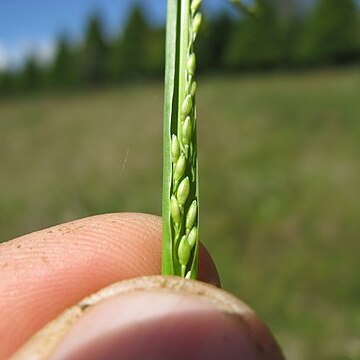Hygrophytic, tufted annual to 650 mm tall, geniculate, rarely erect; culm nodes glabrous. Leaf blade 30-150 x 3-8 mm, glabrous or sparsely hairy, hairs not clavate. Inflorescence 25-100 mm long; not exserted beyond uppermost leaf, which is usually about 8 mm wide, often there are two leaves closely associated with the inflorescence; secondary branches usually absent; spikelets adpressed to branches. Spikelet 2.8-3.4(4.0) mm long, acute, glabrous; lower glume up to 1/3 the spikelet length, 0-1-nerved; upper glume (10-)11-14-nerved; lower floret sterile, lemma (9-)10-11-nerved, palea absent or reduced, if reduced then conspicuously shorter than lower lemma; upper lemma pale to yellow, often flushed dark, smooth, shiny; anthers 0.8-1.0 mm long.
Spikelets 2.5–4 mm. long, ovate-oblong, acute; inferior glume 1/5–1/4 the length of the spikelet, membranous, cuff-like, obtuse or bluntly acute 0–1-nerved; superior glume as long as the spikelet 11-nerved; inferior lemma 9-nerved; its palea absent, sterile; superior lemma and palea glossy.
Panicles 4–10 cm. long, narrowly oblong, seldom fully exserted from the uppermost leaf-sheath, sparsely branched, the branches appressed.
Annual with culms 20–70 cm. high, erect or geniculately ascending, branched, soft.
Leaf laminae 7–15 cm. long and 3–6 mm. wide, linear, flat, sharply acute.


